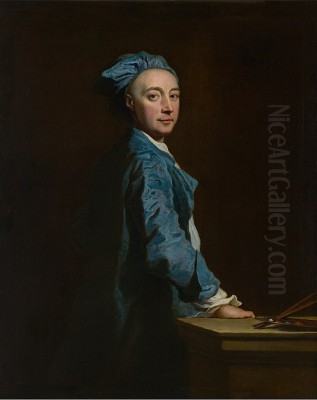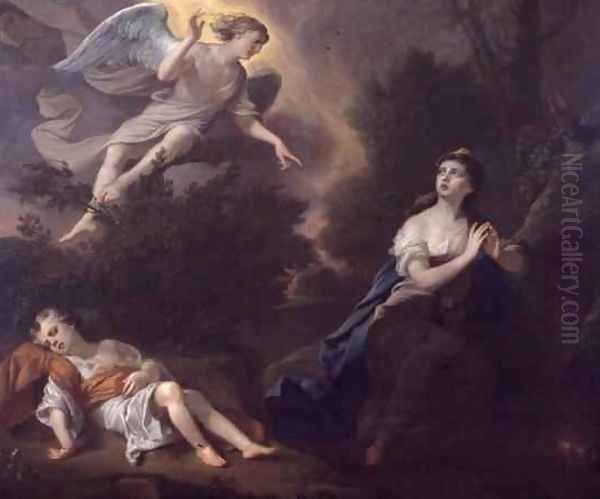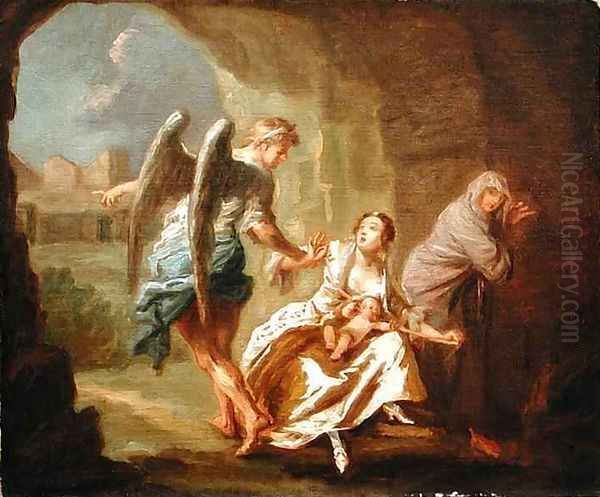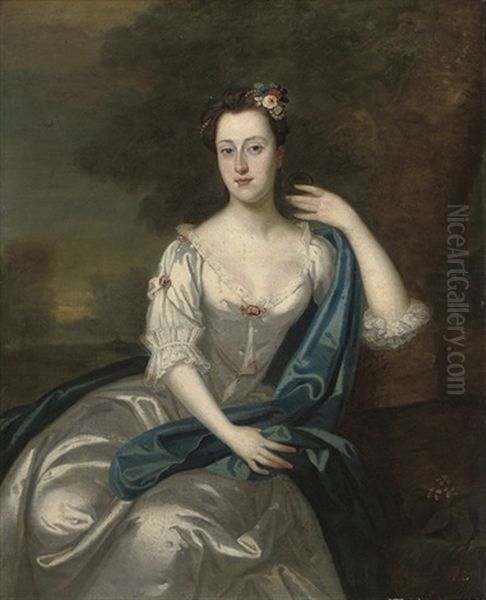
Joseph Highmore stands as a significant, though sometimes underestimated, figure in the landscape of eighteenth-century British art. Active during a period of profound social and cultural transformation, Highmore navigated the worlds of portraiture, narrative illustration, and history painting with a distinctive blend of elegance and observation. Born in London in 1692 and living until 1780, his long career witnessed the shift from the dominance of Baroque portraiture towards the lighter Rococo aesthetic and the burgeoning confidence of a native British school of artists. He was a painter, illustrator, and occasional writer, whose work offers valuable insights into the tastes, aspirations, and anxieties of Georgian society.
Early Life and Artistic Awakening
Joseph Highmore was born in London on June 13, 1692, into a reasonably prosperous middle-class family. His father, Edward Highmore, was a coal merchant, and his uncle was the Reverend Thomas Highmore. Despite showing an early inclination towards art, his family initially steered him towards a more conventional and potentially lucrative profession: the law. For a time, Highmore pursued legal studies and even became a member of the Honourable Society of Lincoln's Inn, one of London's prestigious Inns of Court, around 1710.
However, the pull of art proved irresistible. Around the age of seventeen or eighteen, Highmore made the decisive choice to abandon his legal training and dedicate himself fully to painting. This was a bold move in an era where artistic careers lacked the established structure and social certainty of professions like law or the clergy. His passion evidently outweighed the perceived risks.
To acquire formal training, Highmore enrolled in the academy established in Great Queen Street, London, around 1713. This academy was famously headed by Sir Godfrey Kneller, the German-born painter who had dominated British portraiture for decades and served as Principal Painter to successive monarchs. Studying under Kneller provided Highmore with a solid grounding in the prevailing Baroque portrait style, characterized by its formal compositions, rich colours, and emphasis on conveying the sitter's status and dignity.
The Influence of Kneller and the Rococo

Highmore's early works inevitably show the influence of his teacher, Sir Godfrey Kneller. Kneller's style, while immensely successful and influential, could sometimes tend towards formulaic repetition, a common trait among highly productive portrait studios of the time. Highmore absorbed the technical skills and compositional approaches prevalent in Kneller's studio, focusing on achieving a convincing likeness and rendering textures, particularly the silks, satins, and velvets favoured by the elite clientele.
However, Highmore did not remain solely indebted to the Kneller tradition. The 1720s and 1730s saw the increasing influence of the French Rococo style in London, brought over by immigrant artists and disseminated through prints and imported goods. This style favoured lighter palettes, more dynamic and asymmetrical compositions, intimate subject matter, and a general air of elegance and refinement. Key figures in transmitting this aesthetic to Britain included the French painters Philippe Mercier and Hubert-François Gravelot, both of whom spent significant periods working in London.
Highmore proved receptive to these new artistic currents. His style gradually evolved, shedding some of the formality and robustness of the Kneller school in favour of a more delicate touch, subtler colour harmonies, and a greater sensitivity to capturing the nuances of personality and social interaction. His brushwork became more fluid, and his compositions often incorporated the characteristic curves and decorative flourishes associated with the Rococo. This adaptation allowed him to appeal to the changing tastes of patrons seeking a more modern and graceful style of portraiture. He also sought to broaden his artistic horizons through travel, visiting the Low Countries (specifically Düsseldorf to see the Rubens collection) in 1732 and Paris in 1734, further exposing him to Continental artistic developments.
Success as a Portrait Painter
Highmore established himself as a successful and sought-after portrait painter by the 1720s. His ability to combine a good likeness with a fashionable elegance made him popular among the gentry and the burgeoning professional classes of Georgian London. He developed a reputation for reliable and pleasing portraits that captured both the individual features and the social aspirations of his sitters.
A significant commission came in 1725 with the revival of the Order of the Bath. Highmore was chosen to paint the portraits of several Knights of the Bath in their elaborate ceremonial robes. This prestigious project enhanced his visibility and solidified his standing within the London art world. He maintained a busy portrait practice for several decades, operating from studios in the City and later Lincoln's Inn Fields.

His portraiture is well-represented by works such as A Gentleman in a Brown Velvet Coat (c. 1745-1750, Tate Britain). This painting exemplifies Highmore's mature style: the sitter is presented with quiet confidence, his attire rendered with meticulous attention to the texture and sheen of the velvet coat and the crisp white linen. The pose is relaxed yet dignified, and the characterization suggests a thoughtful and composed individual. Highmore avoids excessive flattery but imbues the subject with an air of refined respectability.
Another notable work is the group portrait, or 'conversation piece', Mr Oldham and His Guests (c. 1730-1740, Tate Britain). This genre, popularized in Britain during the early 18th century by artists like William Hogarth and Gawen Hamilton, depicted informal groups, often families or friends, engaged in genteel activities. Highmore's painting shows a group of men gathered around a table, possibly discussing business or intellectual matters. The composition is carefully arranged, yet conveys a sense of relaxed sociability. It demonstrates Highmore's skill in handling multiple figures and creating a narrative context within a portrait setting. Compared to some of his contemporaries like Thomas Hudson or Jonathan Richardson the Elder, Highmore's portraits often possess a slightly softer, more graceful quality, reflecting the Rococo influence.
Narrative Art: The Pamela Series
Beyond portraiture, Highmore made a crucial contribution to the development of narrative painting in Britain with his series of twelve illustrations for Samuel Richardson's immensely popular novel, Pamela; or, Virtue Rewarded. Published in 1740, Richardson's epistolary novel captivated readers with its story of a virtuous servant girl resisting the advances of her master, Mr. B, eventually leading to her social elevation through marriage.
Highmore painted his Pamela series between 1743 and 1744, likely sensing the commercial potential of visualizing such a well-known story. The twelve paintings depict key moments from the novel, tracing Pamela's trials, tribulations, and eventual triumph. These works were exhibited publicly and subsequently engraved and sold as prints, reaching a wide audience. The original paintings are now divided between Tate Britain, the Fitzwilliam Museum in Cambridge, and the National Gallery of Victoria in Melbourne.
This series is considered a landmark in British art. Along with William Hogarth's celebrated 'modern moral subjects' like A Harlot's Progress (1731-32) and Marriage A-la-Mode (1743-45), Highmore's Pamela paintings helped establish a native tradition of narrative art that drew on contemporary life and literature. While Hogarth's series often employed biting satire and complex allegories, Highmore's approach to Pamela was generally more straightforward and sympathetic to the source material, focusing on illustrating the emotional and dramatic core of Richardson's narrative.

Art historians note that while Highmore effectively captures the settings and actions described by Richardson, his paintings perhaps lack some of the intense psychological drama and moral ambiguity present in the novel. Nevertheless, the Pamela series showcases Highmore's skill in composition, his ability to convey narrative through gesture and expression, and his sensitivity to period detail in costume and setting. The influence of French artists like Gravelot, who was also active as an illustrator in London, can be discerned in the elegant figure types and compositions. Highmore's friendship with Samuel Richardson was clearly important; the author admired the paintings, and they represent a significant collaboration between literature and the visual arts in the period. Other artists like Francis Hayman were also contributing to this burgeoning field of narrative illustration and history painting.
History Painting and Social Commentary
In the 1740s, Highmore turned his attention increasingly towards history painting, often choosing subjects with a strong moral or social dimension. This coincided with his involvement with the Foundling Hospital in London, a charitable institution established by Captain Thomas Coram to care for abandoned children. Like his contemporary William Hogarth, Highmore was an active governor of the hospital and donated works of art to decorate its public rooms, aiming to promote the institution and encourage charitable donations.
For the Foundling Hospital, Highmore painted Hagar and Ishmael (c. 1746). This biblical subject depicts the Old Testament story of Abraham's concubine Hagar and her son Ishmael being cast out into the wilderness. The theme of abandonment and maternal distress resonated powerfully with the hospital's mission. Highmore presents the scene with pathos, emphasizing Hagar's despair and Ishmael's vulnerability, aiming to evoke sympathy and compassion from the viewer. This work placed him alongside other prominent artists contributing to the Foundling Hospital's collection, including Hogarth, Francis Hayman, Allan Ramsay, and later Thomas Gainsborough and Sir Joshua Reynolds.
Perhaps Highmore's most challenging and unconventional history painting is The Angel of Mercy (also known as The Good Samaritan in reverse, c. 1746, Yale Center for British Art). This disturbing work depicts a desperate mother in the act of killing her infant, only to be stayed at the last moment by an intervening angel. The subject matter – infanticide – was shocking and rarely depicted with such raw realism in Western art at the time.
Art historians interpret The Angel of Mercy as a profound commentary on the social pressures, poverty, and lack of support systems that could drive women to such desperate acts in the 18th century. It reflects a growing awareness of, and willingness to confront, difficult social issues, particularly those affecting women and children, themes also explored in the literature of the period. The painting demonstrates Highmore's capacity for tackling complex and emotionally charged subjects, moving beyond the polite conventions of portraiture and Rococo elegance. It reveals a depth and social conscience that adds another layer to his artistic identity, placing him alongside Hogarth as an artist willing to engage with the darker aspects of contemporary society. While history painting struggled for status in Britain compared to portraiture, artists like Highmore, Hogarth, Hayman, and the earlier Sir James Thornhill made significant contributions.
Contemporaries and Artistic Milieu
Joseph Highmore operated within a vibrant and competitive London art world. His career spanned the transition from the dominance of established figures like Sir Godfrey Kneller and the Swedish-born Michael Dahl to the rise of a confident generation of British-born artists. His primary competitor in the realm of elegant portraiture might be considered the Scottish painter Allan Ramsay, whose style also showed a strong French Rococo influence.
In the field of narrative and socially-conscious art, William Hogarth was the towering figure. While both artists created narrative series based on contemporary life and literature, their approaches differed: Hogarth was generally more satirical, complex, and overtly moralizing, while Highmore tended towards greater refinement and a more direct, less critical illustration of his subjects, as seen in the Pamela series. Nonetheless, both were pioneers in establishing narrative painting as a viable genre for British artists.
Highmore's connection with the French émigré artists Philippe Mercier and Hubert-François Gravelot was significant for the development of his Rococo-inflected style. His friendship with the novelist Samuel Richardson was also crucial, leading to the Pamela commission. He would have known many other London artists through shared academies (like the St Martin's Lane Academy, a successor to Kneller's), exhibiting venues (like Vauxhall Gardens), and institutions like the Foundling Hospital. These included portraitists like Thomas Hudson (master of the young Joshua Reynolds) and Francis Hayman, who was active in portraiture, history painting, and decorative schemes.
Later Life, Legacy, and Reassessment
In 1762, at the age of 70, Joseph Highmore retired from his successful painting career. He sold the contents of his studio and moved to Canterbury to live with his daughter Susanna, who was married to a clergyman there. He spent his remaining years in relative quiet, occasionally writing on art theory and perspective, and died in Canterbury on March 3, 1780, at the venerable age of 87. He was buried in the city's St Mary Bredin Church (though the church itself was later demolished).
During his lifetime, Highmore enjoyed considerable success and respect. However, in the later 18th century and throughout the 19th century, his reputation gradually faded. The rise of Sir Joshua Reynolds and Thomas Gainsborough, with their distinct styles and theoretical contributions (in Reynolds' case), came to dominate narratives of 18th-century British art. Highmore, along with other competent painters of his generation, was somewhat overshadowed. Some of his works were even misattributed to the more famous Hogarth.
It was not until the mid-20th century, particularly from the 1960s onwards, that art historians began to reassess Highmore's contribution more fully. Exhibitions and scholarly publications helped to re-establish his identity and highlight the quality and significance of his work. He is now recognized as a key figure in the development of the British Rococo style, a sensitive and skilled portraitist, and an important early practitioner of narrative painting.
His Pamela series remains a cornerstone for understanding the relationship between the novel and visual art in the period. Furthermore, his socially conscious history paintings, especially The Angel of Mercy, are increasingly appreciated for their bold subject matter and their insight into the social and gender dynamics of Georgian England. Highmore is now seen not just as a follower of fashion, but as an artist capable of thoughtful observation and nuanced social commentary.
Conclusion
Joseph Highmore's career exemplifies the opportunities and challenges facing a British artist in the first half of the eighteenth century. Trained in the established Baroque tradition of Kneller, he skillfully adapted to the new elegance of the Rococo, building a successful practice in portraiture. His foray into narrative illustration with the Pamela series marked a significant moment in the history of British art, demonstrating the growing cultural importance of the novel and the desire to create visual narratives rooted in contemporary experience. His later history paintings reveal a deeper engagement with social issues, particularly the plight of women and children. Though his fame was eclipsed for a time, Joseph Highmore is now rightly recognized as a versatile, accomplished, and insightful artist whose work provides a valuable window onto the complexities of Georgian life and culture. He remains an important figure, distinct from but contemporary to giants like Hogarth, and a precursor to the later achievements of Reynolds and Gainsborough.